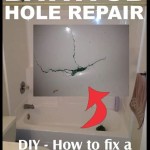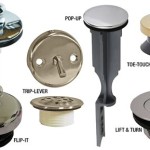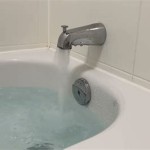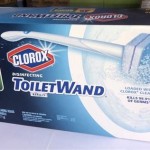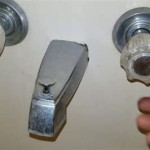Understanding the Bathtub Overflow Plate Mechanism
The bathtub overflow plate is a crucial component of a standard bathtub setup, often overlooked but essential for preventing water damage. Its primary function is to provide an escape route for water when the bathtub fills beyond a certain level, effectively preventing overflow. This mechanism is surprisingly simple in its design and operation, relying on basic principles of physics and plumbing. Understanding how the overflow plate works, its different variations, and the associated problems can equip homeowners with the knowledge to troubleshoot common issues and maintain a functional bathroom.
The core concept behind the bathtub overflow plate is to create an alternative drainage path that activates only when the water level reaches a predetermined height. This height is typically set slightly below the rim of the bathtub. When the water rises to this level, it enters the overflow drain, which is connected to the main drainpipe. This secondary drainage system allows excess water to drain away, preventing spillage onto the bathroom floor.
The components involved in this mechanism include the overflow plate itself, which is the visible part typically located near the faucet, a connecting pipe (often made of PVC or brass) that runs from the overflow plate down to the drainpipe, and a linkage or lever system that may connect the overflow plate to the stopper mechanism in some designs. The specifics of these components and their interaction determine the exact type of overflow system in place.
The design of these systems has evolved over time, with different variations offered to accommodate various aesthetic preferences, plumbing configurations and budgets. Newer models of overflow plates may use complex systems with internal linkages, while older models might rely on simpler, more direct methods of water diversion.
Maintenance of the overflow plate is also an important aspect to consider. Hair, soap scum, and other debris can accumulate in the overflow drain, potentially causing blockages that impede its ability to function effectively. Regular cleaning and inspection of the overflow plate and its associated pipes can help prevent backups and ensure the system operates reliably.
Key Point 1: Core Components and Their Functions
The bathtub overflow system comprises three essential components: the overflow plate, the connecting pipe, and the linkage/lever system (if present). The overflow plate, the most visible part, serves a dual purpose. Firstly, it provides an opening for excess water to enter the overflow drain. Secondly, in many designs, it acts as the control for the drain stopper, allowing the user to open and close the main drain from above the water line.
The connecting pipe extends vertically downward from the overflow plate to the main drainpipe. This pipe is the conduit through which excess water flows when the bathtub reaches the overflow level. The material used for the connecting pipe can vary depending on the age of the plumbing and local building codes. Common materials include PVC, brass, and sometimes even copper.
The linkage or lever system is an optional component that integrates the overflow plate with the drain stopper mechanism. This system allows the user to control the stopper by rotating or pushing/pulling the overflow plate. In these designs, a lever or rod extends from the back of the overflow plate down to the stopper in the drainpipe. Moving the overflow plate manipulates this lever, which in turn raises or lowers the stopper, opening or closing the drain. Simpler designs lack this linkage, relying on a separate stopper mechanism, such as a lift-and-turn drain or a toe-touch drain.
The interaction of these components is critical for proper overflow function. When the water level rises above the overflow opening, water flows through the overflow plate, down the connecting pipe, and into the main drainpipe. If a linkage system is present, manipulating the overflow plate can also control the stopper, allowing the user to empty the bathtub.
Understanding the role of each component is essential for diagnosing and resolving issues with the overflow system. For example, a clogged connecting pipe can prevent the overflow from working, while a broken linkage can render the stopper inoperable.
Key Point 2: Variations in Overflow Plate Design
Bathtub overflow plates come in several designs, each with its own variations in aesthetics and functionality. The most common types include the standard rotary overflow, the trip lever overflow, and the pop-up overflow.
The standard rotary overflow typically features a round plate that can be rotated to control the drain stopper. Rotating the plate in one direction closes the drain, while rotating it in the other direction opens the drain. This design is relatively simple and reliable, but it can be susceptible to wear and tear over time, leading to issues with the stopper mechanism. The aesthetic of a rotary overflow often fits well with more traditional bathroom designs.
The trip lever overflow utilizes a lever that is flipped up or down to control the drain stopper. This design is often found in older bathtubs and is known for its durability. The lever is connected to a linkage system that raises or lowers the stopper. While robust, the trip lever overflow can be more difficult to adjust than other types. The visible appearance can be less sleek than some newer designs.
The pop-up overflow, a more modern design, uses a push-button mechanism to open and close the drain. Pressing the button once closes the drain, while pressing it again opens the drain. This design is often considered more aesthetically pleasing and easier to use than other types. The simpler internal mechanism usually means less frequent maintenance and fewer overall problems. However, pop-up overflows can sometimes be more prone to clogging and may require more frequent cleaning.
Beyond these primary types, there are variations in finish, material, and shape. Overflow plates can be chrome, brushed nickel, oil-rubbed bronze, or other finishes to match the bathroom fixtures. They can be made from metal, plastic, or a combination of materials. The shape can range from simple round plates to more decorative or elongated designs.
The choice of overflow plate design depends on a variety of factors, including personal preference, the style of the bathroom, and the existing plumbing configuration. Understanding the different types available can help homeowners make an informed decision when replacing or upgrading their bathtub fixtures.
Key Point 3: Common Problems and Troubleshooting
Despite their relatively simple design, bathtub overflow systems can experience a variety of problems. Common issues include clogs in the overflow drain, a malfunctioning stopper, and leaks around the overflow plate.
Clogs in the overflow drain are often caused by hair, soap scum, and other debris that accumulate over time. These clogs can prevent the overflow from functioning properly, leading to water damage if the bathtub overflows. To clear a clog, homeowners can use a variety of methods, including a plumber's snake, a wet/dry vacuum, or chemical drain cleaners. It is important to exercise caution when using chemical drain cleaners, as they can damage pipes and pose a health hazard. Prevention is key to avoiding clogs, so regular cleaning of the overflow drain is recommended.
A malfunctioning stopper can prevent the bathtub from holding water or draining properly. This issue can be caused by a broken linkage, a worn-out stopper, or a misaligned stopper. If the linkage is broken, it will need to be repaired or replaced. A worn-out stopper may need to be replaced as well. A misaligned stopper can often be adjusted by loosening the set screw on the overflow plate and repositioning the stopper.
Leaks around the overflow plate can be caused by a loose connection, a damaged gasket, or corroded pipes. To fix a leak, homeowners should first tighten the screws that secure the overflow plate to the bathtub. If this does not stop the leak, the gasket may need to be replaced. In cases of corrosion, the pipes may need to be repaired or replaced by a qualified plumber.
When troubleshooting overflow plate problems, it is important to identify the specific issue and take appropriate action. In some cases, a simple cleaning or adjustment may be all that is needed. In other cases, more extensive repairs or replacements may be required. If unsure how to proceed, it is always best to consult a qualified plumber.
Proper maintenance and timely repairs can help ensure the bathtub overflow system operates reliably and prevents water damage. Regular inspection and cleaning can also help identify potential problems before they become major issues.

Drain Overflow Assemblies Fine Homebuilding

What Is A Bathtub Overflow Drain 2025 Guide With Examples And Photos Badeloft

7 Bathtub Plumbing Installation Drain Diagrams

7 Bathtub Plumbing Installation Drain Diagrams

Bathroom Fixtures How Do You Turn The Overfow Drain In Tub Upside Down Home Improvement Stack Exchange

Bath Waste Overflow Guide 101 Size Materials And Finish Hofen Drain

What Is A Bathtub Overflow Drain Does All Tubs Have

How To Fix A Leaking Bathtub Overflow Drain Diy Guide

Bathtub Parts Everyone Should Know About Part Names 2024

Should You Worry About Your Bath Overflowing Helpful Colin
Related Posts

